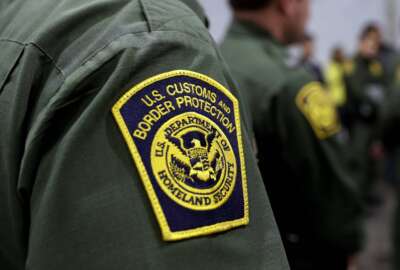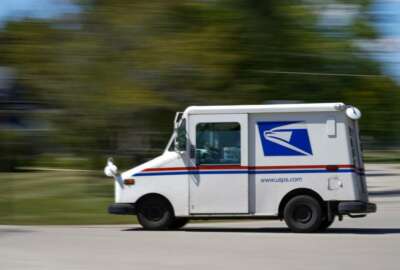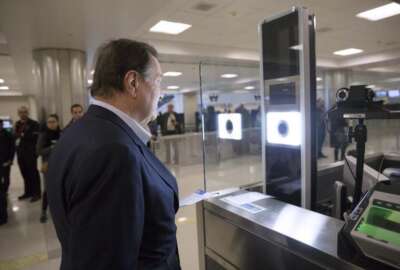GSA outlines plan to spend $3.4B on infrastructure upgrades along US borders
The General Services Administration is moving ahead with a multi-billion-dollar upgrade of its land ports of entry along the country’s northern and southern...
The General Services Administration, as part of the Biden administration’s infrastructure agenda, is moving ahead with a multi-billion-dollar upgrade of its land ports of entry along the country’s northern and southern borders.
GSA plans to spend $3.4 billion to modernize 26 land ports of entry along the U.S. borders with Canada and Mexico.
The agency received this funding as part of the $1 trillion bipartisan infrastructure spending plan that President Joe Biden signed into law last November.
While the port modernization projects vary in terms of speed and complexity, GSA expects to award some contracts before the end of the year.
White House Senior Adviser and Infrastructure Coordinator Mitch Landrieu told reporters in a call Thursday that the U.S. has historically underfunded its port infrastructure, which has a “real cost to our families, our economy and global competitiveness.”
These upgrades, he added, would reduce bottlenecks, ensure goods arrive on shelves faster and enhance U.S. border security.
“Most land ports operate at full capacity and have surpassed the needs for which they were designed,” Landrieu said.
GSA Administrator Robin Carnahan said the land ports selected for modernization are, on average, 40 years old, and haven’t kept up with increasing trade in recent years.
“What that means, of course, is longer wait times at these borders for the 160,000 passenger vehicles and 34,000 trucks that cross, every day, our borders, carrying billions of dollars in goods,” Carnahan said.
These construction and modernization projects will expand capacity, introduce new technology to process traffic and increase energy efficiency.
“These upgrades that we’re talking about today are long overdue. They’re smart investments, we know that it’s going to turn into jobs and more economic growth going forward,” Carnahan said.
The National Treasury Employees Union, which represents Customs and Border Protection employees who work at the U.S. ports of entry, supports the administration’s plans to upgrade and modernize land ports of entry.
NTEU President Tony Reardon said these investments will “improve the flow of legitimate trade and travel and help grow the American economy.”
“CBP employees are proud to play an important role in our country’s economic growth. The upgrades should also assist CBP employees tasked with interdicting illegal drugs, counterfeit products and other illicit goods by modernizing the technology and tools used in that process,” Reardon said. “In addition to improving the efficiency of CBP operations, the employees we represent would also benefit from a safer, more modern workplace.”
GSA owns and operates 102 land ports of entry along the northern and southern U.S. borders, and has completed several one-off upgrades in recent years.
The agency, in 2019, added eight additional lanes to the San Ysidro port of entry in California. In 2014, it completed upgrades at the Nogales-Mariposa port of entry Arizona, which reduced commercial wait times by 25%.
These upcoming modernization projects will also give Customs and Border Protection the latest technology to identify high-risk activity and shipments, combat drug trafficking and increase operational security.
CBP Commissioner Chris Magnus called this level of spending a “once-in-a-generation investment” that will enhance the agency’s ability to facilitate trade and protect the country’s borders.
“CBP’s ability to identify, screen, and inspect high-risk persons or cargo depends greatly on the operational utility of its land port of entry inspection facilities,” Magnus said. “This investment will improve our operational capabilities and facility infrastructure, as well as help mitigate the negative economic impact of border wait times, facilitate the economic development and growth in the border communities, and benefit the American economy on the border and beyond.”
Among the projects, GSA expects to spend about $200 million to build a new commercial port in Douglas, Arizona, to facilitate the crossing of commercial goods, produce and equipment.
Carnahan said the existing port of entry is located downtown, which has led to increased traffic for the area. GSA is working with the city and the state of Arizona to find a new location outside of town to divert commercial traffic.
“The situation there now is not sustainable, to keep putting these big commercial oversized trucks through the middle of that city,” Carnahan said.
Sen. Kyrsten Sinema (D-Ariz.) said the new port will expand U.S.-Mexico trade opportunities, reduce transportation delays and give CBP better technology to detect illegal drugs crossing the border.
“Most seizures of illicit drugs at our border happen at ports of entry, so by modernizing the existing Douglas port, we’re helping our men and women on the front lines more easily interdict bad actors, and slow the flow of illegal activity,” Sinema said
Carnahan said the 26 projects receiving funding vary in complexity, and are on different timelines.
GSA expects to award contracts for projects at the Calexico West, California and San Luis, Arizona, ports of entry by the end of this year. However, Carnahan others “are going to be on a longer timeline.”
“They’re all kind of at different phases and different levels of complexity. These are long-term investments, and so each is going to be dealt with a bit differently. Some are going to take more communicating with neighborhoods and communities than others,” she said.
GSA expects to spend $100 million to complete the final phase of a modernization and expansion project at the Calexico West port of entry, and more than $115 million to complete the modernization of the San Luis port of entry.
Carnahan said the technology upgrades will include providing broadband access to ports in remote areas, while also increasing sustainability.
“We know that this is a major priority for the administration, and we know that the technologies have changed so dramatically in the last 10 or 15 years,” Carnahan said.
Landrieu said these port upgrades will also take cybersecurity and environmental sustainability into consideration.
“All of this building will be informed by resilience and climate, and making sure that we use materials that are sustainable, but also make sure that we build these things to withstand whatever climate challenges we have coming our way, whether we’re in the north or the south,” Landrieu said.
The Biden administration, meanwhile, expects spending on these projects will support technologies that help agencies reach green-government goals.
“The president wants to use the power of the purse to incentivize good choices,” Landrieu said.
President Joe Biden, as part of an executive order he signed in December, expects agencies to reach net-zero greenhouse gas emissions across all federal operations by 2050, including a 65% reduction by 2030.
The executive order also created a Buy Clean Task Force to promote the use of lower-emission construction materials.
GSA last week issued two requests for information to gather insights on sustainable, low-emission concrete and asphalt materials.
Copyright © 2025 Federal News Network. All rights reserved. This website is not intended for users located within the European Economic Area.
Jory Heckman is a reporter at Federal News Network covering U.S. Postal Service, IRS, big data and technology issues.
Follow @jheckmanWFED






